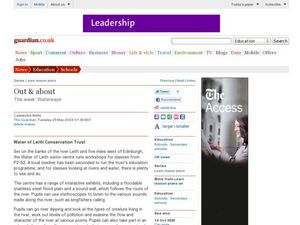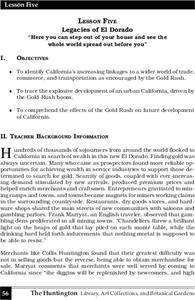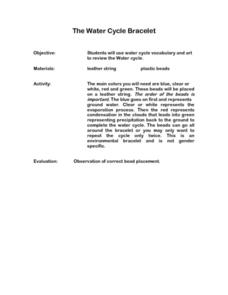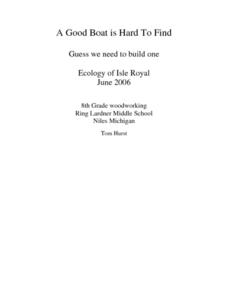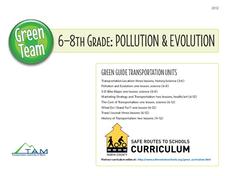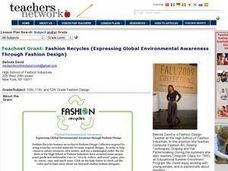Curated OER
Returning to the South
Learners reinforce their knowledge of the Great Migration by reading a narrative to investigate reasons why African-Americans chose to migrate from the South. Students then write editorials for a local newspaper that outlines the reasons...
Curated OER
Ancient Mediterranean Trade Fair
Sixth graders begin the lesson by discussing how artifacts are located. In groups, they define the terms supply, demand, resources and trade and discuss how the United States is affected by International trade. They use this...
Curated OER
Little House in the Census: Almanzo and Laura Ingalls Wilder
Students view copies of the 1880 and 1900 censuses and then create and conduct their own census of their homes, comparing all three.
Curated OER
Out & About: Waterways
Students visit science museums. In this hands-on science lesson, students visit the Leith Conservation Trust, Catalyst, and the River and Rowing Museum in person or online to study Britain's waterways.
Curated OER
Learning About the Great Inventor: Thomas Edison Lesson Plans
Thomas Edison facts can inspire students to create their own inventions, and persevere despite adversity.
Curated OER
Legacies of El Dorado
Students explore the development of urban California as it was driven by the Gold Rush boom. They study historical documents and participate in a variety of hands-on activities designed to reinforce the concept of the lesson.
Curated OER
The Water Cycle Bracelet
Students participate in a creative project in order to investigate the water cycle. They create a bracelet with different colored beads that represent the concept and the order of its occurrence. Students are evaluated according to the...
Curated OER
How to Catch a Fish
Students conduct an experiment to demonstrate the effects of different fishing methods. In this commercial fishing lesson students create posters and public announcements to share their information.
Curated OER
Poisoned Chalice
Learners explore espionage. In this current events instructional activity, students research various Web sites for information about the history of spy work, Anglo-Russian relations, and spy gadgets.
Curated OER
A Good Boat is Hard To Find
Eighth graders design and construct a safe and efficient human powered watercraft that can be used on a trip on the Great Lakes. Students utilize math and measurement skills to design and cut the pieces for their boat. Working in...
Curated OER
Studying the Food Pyramid
Students explore the food pyramid and how to eat a healthy diet. In this nutrition lesson, students use pictures to make charts of food from the different food groups, record the food they eat throughout the day, investigate the...
Curated OER
Play on Architecture
Learners describe how buildings effect them emotionally. They recognize and describe at least five components of a particular building as metaphors for parts of the human body [Footing), heart(h), eye (window), door(mouth), face(facade),...
Curated OER
Red Dirt Groundbreakers
Discover Oklahoma's first farmers. Read about 14 different agriculture workers and their contribution to Oklahoma's farming. After reading, have your class complete several activities such as researching an agriculturist, writing a...
Safe Routes to School
Pollution & Evolution
Bring together a study of two major scientific topics with a lesson on the relationship between pollution and evolution. With the help of a PowerPoint presentation, hands-on activity. and class demonstration young scientists learn...
NET Foundation for Television
1850-1874 Beef Moves to Nebraska
Just how long was the Long Drive? Learners investigate the movement of cattle in the Great Plains during the mid-1800s. They incorporate photographic, newspaper, video, and primary source evidence into their posters, artwork, and written...
Curated OER
In Search of Reused and Recycled
Students identify recycled and recyclable products by reading labels. They discuss what happens to solid waste in landfills and its impact on the environment. They discuss ways in which they can conserve natural resources.
Curated OER
Ocean Market
Students research how: The ocean is the source of many materials, from ores mined from its depths to relaxing mineral salts for a bath. Exquisite mother-of-pearl inlay, decorative shells, and pearl jewelry are found in gift shops...
Curated OER
Teaching About Trade in the Ancient Mediterranean
Sixth graders examine the trade routes in the Mediterranean of the Ancient world. In groups, they view slides of artifacts while answering questions on a worksheet. After watching a video, they discuss how each object was found and...
Curated OER
Crystal Growing
Students grow crystals and document their observations by recording timeing and growth. Additional characteristics of crystals are observed under a black light, by growing under different conditions and mineral content is determined.
Curated OER
Civic Engagement for Us?
Students identify the different forms of civic engagement. They identify their responsibilities at the different levels of government. They also analyze young leaders running for office.
Curated OER
"The Merchants of Cool"
Why are so many advertisements geared towards the teenage population? Watch a video with your class (link included), and have them fill out the attached listening guide. Then discuss persuasion, presenting biased information, and where...
Curated OER
Fashion Recycles
Complete fashion design activities as a part of a study on protecting the environment. In this fashion and environment lesson, students discuss global environmental awareness and work in groups to list recyclable products that can be...
Curated OER
The Business of Credit
Students explore the concept of credit. In this credit lesson, students discuss the necessities to start-up a new business. Students discuss cost of a new business, loans, and credit. Students create their own business and apply what...
Curated OER
Tolerance in Times of Trial
Students view the treatment of people of Japanese and German descent during World War II. They explore the problems in assigning blame to populations during times of war. They identify modern examples of discrimination and stereotyping.



